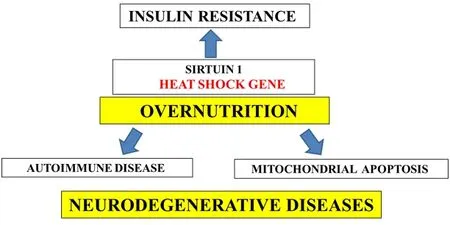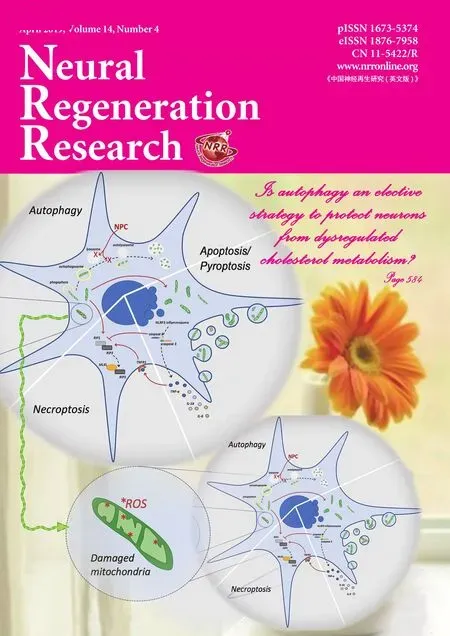Human survival and immune mediated mitophagy in neuroplasticity disorders
Dear editors,
Neurodegenerative diseases are now associated with the global obesity and diabetes epidemic in the developing and developed world. Neurodegenerative diseases are a heterogeneous group of disorders with complex factors such as neurohumoral, endocrine and environmental factors involved in induction of these neurodegenerative diseases. The future of science and medicine in neurodegenerative diseases is now dependent on nutritional genomics with insulin resistance a major factor in the induction of neurodegenerative diseases. Nutritional genomics now involves the anti-aging gene Sirtuin 1 (Sirt 1) that is important to the prevention of insulin resistance with its critical involvement in the immune system (Martins, 2018a, b). Sirt 1 inactivation leads to toxic immune reactions connected to the acceleration of neuron death in various communities. Appetite control with relevance to immunometabolism has become of critical importance to the treatment of neurodegeneration (Figure 1). Nutritional diets activate the heat shock gene Sirt 1 to prevent the increase in heat shock proteins connected to autoimmune disease, mitophagy (Martins, 2018a, b) and irreversible programmed cell death in global populations (Figure 1).

Figure 1 Overnutrition associated with Sirtuin 1 repression is a major factor involved with insulin resistance and the induction of neurodegenerative diseases.
Sirt 1 is a nicotinamide adenine dinucleotide dependent class III histone deacetylase that targets transcription factors to adapt gene expression to metabolic activity and the deacetylation of nuclear receptors indicate its critical involvement in insulin resistance and neurodevelopment. Regulation of Sirt 1 (acute phase protein) by nutrition is essential to maintain neuron proliferation. Sirt 1 is involved with the control of the circadian rhythm critical to the immune response in various chronic diseases. Sirt 1 is essential for mitochondrial biogenesis and cell proliferation in various cells. In the brain heat shock gene Sirt 1 inactivation leads to the formation of toxic immunogenic proteins that induce mitochondrial apoptosis and acute neuron death in neurodegenerative diseases.
Laboratory evaluation that involve early plasma Sirt 1 measurement is essential for the diagnosis and management of immune-mediated disorders with relevance to immune mediated control of synaptic plasticity and epileptic stroke. Environmental factors such as xenobiotics (Brown et al., 2005; Mandolesi et al., 2017; Martins, 2018c) and core body temperature have become important to neural plasticity with heat shock gene inactivation (Martins, 2018a) associated with mitophagy and neuron apoptosis. The structural organization of the brain (Vance et al., 2012; Shaffer, 2016) is connected to Sirt 1 interactions between neurons and synapses with Sirt 1 critical to neural stem cell renewal (Herskovits and Guarente, 2014; Cai et al., 2016).
Major interests in neurological rehabilitation have now indicated the involvement of the cytosekeleton in neuroplasticity disorders(Gordon-Weeks and Fournier, 2014) but Sirt 1 repression associated with mitophagy remains the major cause of accelerated neuron death in the brain of man and animals.
Human survival and autoimmune disease (Martins, 2018a, b) is now relevant to synaptic plasticity (Figure 2) and brain regeneration(Martins, 2017). Appetite control, core body temperature and diet are essential to maintain brain Sirt 1 levels and to prevent the generation of immunogenic lipids and proteins that induce mitophagy and programmed cell death. Nutritional genomics that involves the Sirt 1 regulation determines suprachiasmatic nuclues regulation (Martins,2018a, b) that is now important to circadian clock control connected to the sleep-to-wake cycle, appetite, body temperature and hormone regulation (Dierickx et al., 2018). Suprachiasmatic nucleus defects and immunometabolism are now connected to the primary induction of mitophagy with the acceleration of neuroplasticity disorders in neurodegenerative diseases in the developed and developing world.

Figure 2 Factors that determine neuroplasticity determine thestructural organization of the brain.
Conclusion:Environmental factors such as core body temperature,xenobiotics and diet have become important to brain regeneration and with heat shock gene inactivation associated with mitophagy and neuron apoptosis in various species. Sirt 1 determines the fate of neural cells with diet and immunology now critical to the prevention of immune-mediated mitophagy and the promotion of neural stem cell renewal.
This work was supported by grants from Edith Cowan University, the McCusker Alzheimer’s Research Foundation and the National Health and Medical Research Council.
Ian James Martins*
Centre of Excellence in Alzheimer’s Disease Research and Care, Sarich Neuroscience Research Institute, Edith Cowan University, Nedlands,Western Australia, Australia; School of Psychiatry and Clinical Neurosciences, The University of Western Australia, Nedlands, Western Australia, Australia; McCusker Alzheimer’s Research Foundation,Hollywood Medical Centre, Nedlands, Western Australia, Australia
*Correspondence to:Ian James Martins, PhD,i.martins@ecu.edu.au.
orcid:0000-0002-2390-1501 (Ian James Martins)
Received:June 5, 2018
Accepted:September 21, 2018
doi:10.4103/1673-5374.247482 Martins IJ (2019) Human survival and immune mediated mitophagy in neuroplasticity disorders. Neural Regen Res 14(4):735.
Conflicts of interest:None declared.
Open peer reviewers:Hans-Gert Bernstein, Otto-von-Guericke University Magdeburg,Germany; Sage Arbor, Marian University College of Osteopathic Medicine, USA; Anindita Banerjee, ICARE Institute of Medical Sciences and Research and Dr BC Roy Hospital, India.
Additional file:Open peer review reports 1–3.
 中國(guó)神經(jīng)再生研究(英文版)2019年4期
中國(guó)神經(jīng)再生研究(英文版)2019年4期
- 中國(guó)神經(jīng)再生研究(英文版)的其它文章
- Voluntary running delays primary degeneration in rat retinas after partial optic nerve transection
- Neuroprotective effects of rapamycin on spinal cord injury in rats by increasing autophagy and Akt signaling
- Establishment and verification of a surgical prognostic model for cervical spinal cord injury without radiological abnormality
- Repair of peripheral nerve defects by nerve transposition using small gap bio-sleeve suture with different inner diameters at both ends
- Reinnervation of spinal cord anterior horn cells after median nerve repair using transposition with other nerves
- Repair of long segmental ulnar nerve defects in rats by several different kinds of nerve transposition
